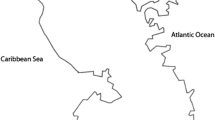Abstract
The Cookiecutter Shark (Isistius brasiliensis) is an ecto-parasitic predator of numerous large pelagic fish and mammals. However, little is known of its foraging ecology due to its elusive foraging tactics in the pelagic environment. We used bite scar patterns on pelagic fishes landed at the Honolulu Fish Auction to assess some of the Cookiecutter Shark foraging habits. Swordfish (Xiphias gladius) had the greatest percentage of bites (87.9 ± 25.0% of individuals had healed scars) followed by Opah (Lampris guttatus, 33.0 ± 8.3% of individuals). Most fish with scars only had one Cookiecutter Shark bite per individual with the exception of Swordfish, which often had >5 bites per individual. Furthermore, Swordfish had a higher proportion of healed bite scars meaning they had been attacked while free-swimming. Seasonal changes in the probability of hooked fish being bitten by sharks were apparent for Swordfish, Bigeye Tuna and Opah. Based on bite scar diameter, larger Cookiecutter Sharks may preferentially attack Swordfish rather than the other species of pelagic fish. When taken in conjunction with diving behavior of pelagic fish, and fishing depths, the results add further support to the hypothesis that Cookiecutter Sharks perform diel vertical migrations.






Similar content being viewed by others
References
Bigelow K, Musyl MK, Poisson F, Kleiber P (2006) Pelagic longline gear depth and shoaling. Fish Res 77:173–183
Brill RW, Holts DB, Chang RKC, Sullivan S, Dewar H, Carey FG (1993) Vertical and horizontal movements of Striped Marlin (Tetrapturus audax) near the Hawaiian Islands, determined by ultrasonic telemetry, with simultaneous measurements of oceanic currents. Mar Biol 117(4):567–574
Brill RW, Block BA, Boggs CH, Bigelow KA, Freund EV, Marcinek DJ (1999) Horizontal movements and depth distribution of large adult Yellowfin Tuna (Thunnus albacares) near the Hawaiian Islands, recorded using ultrasonic telemetry: implications for the physiological ecology of pelagic fishes. Mar Biol 133:395–408
Cadenat J, Blache J (1981) Requin de Mediterranee et d’Atlantique (Plus Particulierement de la Cote Occidentale d’Afrique) (Faune Tropicale, vol. 21). Office de la Recherche Scientifique et Technique Outre-Mer, Paris
Carey FG, Robison BH (1981) Daily patterns in the activities of Swordfish Xiphias gladius, observed by acoustic telemetry. Fish Bull US 79:277–292
Compagno LV, Dando M, Fowler S (2005) Sharks of the world. Princeton University Press, Princeton
Dagorn L, Bach P, Josse E (2000) Movement patterns of large Bigeye Tuna (Thunnus obesus) in the open ocean, determined using ultrasonic telemetry. Mar Biol 136(2):361–371
Evans K, Morrice M, Hindell M, Thiele D (2002) Three mass strandings of sperm whales (Physeter macrocephalus) in southern Australian waters. Mar Mamm Sci 18(3):622–643
He X, Bigelow KA, Boggs CH (2006) Cluster analysis of longline sets and fishing strategies within the Hawaii-based fishery. Fish Res 31:147–158
Hiruki LM, Gilmartin WG, Becker BL, Stirling I (1993) Wounding in Hawaiian monk seals (Monachus schauinslandi). Can J Zool 71:458–468
Holland KN, Brill R, Chang RKC (1990) Horizontal and vertical movements of Pacific Blue Marlin captured and released using sportfishing gear. Fish Bull 88:397–402
Jahn AE, Haedrich RL (1987) Notes on the pelagic squaloid shark Isistius brasiliensis. Biol Ocean 5:297–309
Johnson SC (1978) Sea creatures and the problem of equipment damage. U.S. Nav. Inst. Proc. 106–107
Jones EC (1971) Isistius brasiliensis, a squaloid shark, the probable cause of crater wounds on fishes and cetaceans. Fish Bull US 69:791–798
Le Boeuf BJ, McCosker JE, Hewitt J (1987) Crater wounds on northern elephant seals: the Cookiecutter Shark strikes again. Fish Bull 85(2):387–392
McSweeney DJ, Baird RB, Mahaffy SD (2007) Site fidelity, associations, and movements of cuviers (Ziphius cavirostris) and blainvilles (Mesoplodon densirostris) beaked whales off the island of Hawaii. Mar Mamm Sci 23(3):666–687
Muñoz-Chápuli R, Rel Salgado JC, De La Serna JM (1988) Biogeography of Isistius brasiliensis in the North-Eastern Atlantic, inferred from crater wounds on Swordfish (Xiphias gladius). J Mar Biol Assoc UK 68:315–321
Nakano H, Nagasawa K (1996) Distribution of pelagic elasmobranchs caught by salmon research gillnets in the north pacific. Fish Sci 62(5):860–865
Nakano H, Tabuchi M (1990) Occurrence of the Cookiecutter Shark. Isistius brasiliensis in surface water of the North Pacific Ocean. Jpn J Ichthyol 37(1):60–63
Polovina JJ, Hawn D, Abecassis M (2008) Vertical movements and habitat of Opah (Lampriss guttatus) in the central north Pacific recorded with pop-up archival tags. Mar Biol 153(3):257–267
Shirai S, Nakaya K (1992) Functional morphology of feeding apparatus of the Cookiecutter Shark, Isistius brasiliensis, (Elasmobranchii, Dalatiinae). Zool Sci 9:811–821
Widder EA (1998) A predatory use of counter-illumination by the squaloid shark, Isistius brasiliensis. Environ Biol Fish 53:267–273
Acknowledgements
We would like to thank B. Takenaka for providing us with continuous access to the Honolulu fish auction. We would like to thank J. Dale, N. Whitney, and L. Davis for helping with auction sampling. Finally, we would also like to thank J. McCosker and two anonymous reviewers whose comments improved the manuscript. This is a contribution of the MBA/HIMB Collaborative Research Program.
Author information
Authors and Affiliations
Corresponding author
Rights and permissions
About this article
Cite this article
Papastamatiou, Y.P., Wetherbee, B.M., O’Sullivan, J. et al. Foraging ecology of Cookiecutter Sharks (Isistius brasiliensis) on pelagic fishes in Hawaii, inferred from prey bite wounds. Environ Biol Fish 88, 361–368 (2010). https://doi.org/10.1007/s10641-010-9649-2
Received:
Accepted:
Published:
Issue Date:
DOI: https://doi.org/10.1007/s10641-010-9649-2




